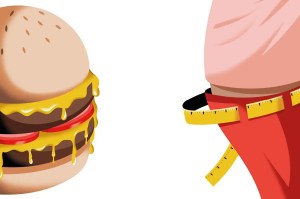Imagine a movement of alcoholics wanting to glorify alcoholism. They’ll claim alcoholism is normal, even healthy. They’ll charge anyone who says otherwise as infected by a societally instilled form of methyphobia, the abject fear of alcohol. The movement will be sponsored by the alcohol industry, eager to gin up sales with the advent of “alcoholic positivity” promoting their addictive beverages. There will even be conferences around the country featuring activist alcoholics selling alcoholism as beautiful.
The same movement is happening today with food.
TLC’s My 600-Lb Life returns with season twelve on Wednesday. Each episode offers a painful illustration of the consequences of extreme food addiction glorified today by activists for “body positivity.” The network’s low-paid stars are paraded around on television suffocating under their own weight as they desperately pursue bariatric surgery from Houston doctor Younan Nowzaradan. Is TLC exploiting these people, pulled from the lowest rings of society, for cheap entertainment? Or is the show offering Americans the service of a graphic warning about the consequences of extreme obesity? Probably a mix of both. While reality television might exist to mock, nothing about these patients’ lifestyles, which have been completely taken over by a debilitating addiction to food, could be construed as “positive.”
In season nine, twenty-three-year-old Nicole Lewis of Marion, Ohio, is so big at 684 pounds that she couldn’t fit through the bathroom door of her own home. Her size forced her to endure the public humiliation of having her husband hose her down on the outdoor porch to keep clean, a scene broadcast on national television.
In season four, Lupita (“Lupé”) Samano, then thirty-nine, was featured on screen breaking the toilet at the bariatric surgeon’s office. Samano hadn’t walked on her own for ten years after she went into a diabetic coma with so much fat around her neck that doctors had to insert a trachea for the ventilator. “I walked into the ER and I never walked out,” she said.
Season five opened with thirty-eight-year-old Kirsten Perez sobbing in the shower because she can’t stand long enough in the shower. “I’m completely miserable every day, every moment, of every minute of every second,” she explained.
“I feel like I’m in jail,” Perez said. “I’m a prisoner of this fat.” The language is identical to drug addicts who describe their inescapable relationship with toxic substances.
Many of TLC’s televised patients have caretakers whose lives are on hold to cater the addiction. Daily life remains a struggle. Many have lost jobs because of their weight. Travel is a nightmare; rudimentary tasks such as bathing and cooking require herculean efforts, assuming they can lift their 600-pound bodies out of bed in the first place. Some can’t even drive because they can’t fit in the driver’s seat of a car. Yet the addiction is so strong that at 678 pounds, Janine Mueller still finds her way to the fast food drive-thru in her motorized scooter.
“They used to have those sideshows where you’d go and pay ten cents to see the fat lady,” Mueller said in season six. “Now all they have to do is wait and see if I leave my apartment.”
Mueller went on to describe the euphoria that ensues when she’s back home and takes the first bite. “I just try to get my food and get home as quickly as possible, because once that food is in my mouth, the rest of the world just fades away.” The feeling she described has a name in the food industry to characterize the precise mix of ingredients to mesmerize consumers. It’s called the “bliss point.”
Pulitzer-prize winning investigative reporter Michael Moss wrote extensively about the bliss point in his 2013 book, Salt Sugar Fat: How the Food Giants Hooked Us.
“Its origins are murky, having some roots in economic theory,” Moss explained. “In relation to sugar, however, the term appears to have been coined in the 1970s by a Hungarian-born mathematician named Joseph L. Balintfy, who used computer modeling to predict eating behavior. The concept has obsessed the food industry ever since.”
The subjects of TLC’s program are always hypnotized into a trance state whenever their cravings are indulged with plates upon plates of industrially manufactured products masquerading as food. Whether it’s waffles, candy bars, donuts or potato chips, it’s all junk food chemically engineered to be maximally addictive right down to the texture of the crunch, activating the same reward centers in the brain as drugs and alcohol. Researchers have found sugar in particular as more rewarding than cocaine. Public health authorities might reserve the “addiction” label for illicit substances such as cannabis and heroin but it’s clear by watching My 600-Lb. Life that everybody is a “junkie.”
Food is the addiction activists have sought to normalize. Lindo Bacon’s 2010 book, Health at Every Size, (published as “Linda” with a PhD in physiology, Bacon now uses “they/them” pronouns), has become the Bible for body positivity used to justify instant gratification with toxic food addiction under the smokescreen of self-love. “The best way to win the war against fat,” Bacon wrote in the introduction, “is to give up the fight.”
Bacon offered readers a roadmap to “health” by encouraging a different approach to dieting by eliminating the idea altogether. “Just give up,” they wrote. “Yes, give up.”
Bacon’s suggestions relied on a study they led with seventy-eight women aged thirty to forty-five who were non-smokers randomly assigned to two groups, the “Health at Every Size [HAES] group” and the “conventional diet program group.” The women in the HAES program were presented with messages of “body acceptance” and “self-acceptance” as well as an early draft of the book, while the other women received generic advice to journal their food, engage in moderate exercise and practice calorie restriction. Most importantly, the latter group was instructed on counting grams of fat, a key macronutrient inappropriately demonized by the medical establishment as the primary culprit in obesity and chronic disease. Each group was divided into another four groups which met regularly over twelve months for communal support and individual attention. The participants were followed up with after two years.
“The HAES program won hands down,” Bacon reported, outlining the results showing “significant declines in levels of so-called ‘bad’ LDL cholesterol and blood pressure.” These women as “quadrupled the amount of energy they spent being active and told us they felt more vital and enjoyed their bodies more.”
The conventional dieters, on the other hand, suffered in activity level, depression and blood pressure. “And here’s the final nail in the dieting coffin,” Bacon wrote, “the dieters’ self-esteem plummeted while the HAES women grew more empowered.”
Several flaws in Bacon’s study, however, should give any reasonable dietician pause before embracing the radical acceptance movement of “Health at Every Size.” For one, the conventional dieters were not only taught to restrict dietary fat consumption, but were also told to keep calories to a minimum. Calories, however, are far from equal. The amount of fiber, protein, sugar and fat in foods, combined with body chemistry, will decide how each calorie is metabolized. One hundred calories from a handful of nuts, for example, is going to be digested differently from 100 calories of ice cream. Even “zero-calorie” beverages may contribute to weight gain by triggering adverse effects on metabolism and appetite.
The women who showed improvement, on the other hand, reportedly saw better blood pressure and self-esteem, the latter of which is scientifically vague. This might be better for mental health but “better” isn’t synonymous with healthy. Bacon wrote nothing about these individuals’ body fat percentage or insulin sensitivity, two important indicators for the development of chronic disease. Meanwhile, the women who lost weight gained it all back.
The reality is at least 88 percent of Americans exhibit at least one sign of metabolic dysfunction, with important implications for the heart, kidneys and brain. More than 73 percent of US adults twenty and older are at minimum, overweight. Nearly 42 percent are obese. In other words, we’re not healthy at any size as four in ten American adults already suffer with at least two or more chronic diseases, according to the Centers for Disease Control (CDC). Obesity alone is associated with stroke, cancer, diabetes, depression and heart disease, to name a few.
None of this has stopped medical professionals from embracing “Health at Every Size.” Last fall, a Philadelphia service provider committed to an approach called the Radiance Medical Group was a sponsor of the city’s first “fat people” convention featuring celebrity “fat speakers, influencers, performers” and more. When asked how much the group made treating obesity and related illnesses the year prior, the practice denied any profit.
“We make ZERO DOLLARS on this,” Dr. Vicky Borgia wrote in an email. “We make money caring for the health of ALL people.”
The CDC estimates obesity costs the healthcare industry $173 billion every year. There’s a lot more money to be made in compliance with “Health at Every Size” than promoting the cure.






















Leave a Reply